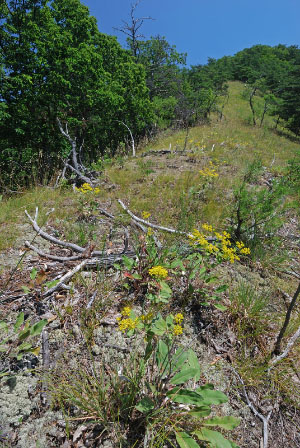
 Department of Conservation and Recreation
Department of Conservation and Recreation
Conserve. Protect. Enjoy.
 Department of Conservation and Recreation
Department of Conservation and Recreation
 Table of Contents
Table of ContentsCentral Appalachian Shale Barrens
This is a variable group of woodlands, shrublands, and open herbaceous rock outcrops occurring on Ridge and Valley shales and Blue Ridge metashales of the central Appalachian Mountains. These small-patch communities are endemic to western Virginia, eastern West Virginia, west-central Maryland, and south-central Pennsylvania. In Virginia, they occur at elevations from 300 to 850 m (1,000 to 2,600 ft). Habitats generally occur on steep (~ 30 degree) slopes with south to west aspects. The steep, xeric slopes and friable nature of the shale create poorly vegetated hillsides of bare bedrock and loose channery visible from afar. Continual undercutting of thick but relatively weak shale strata by streams maintain most shale barrens. Less common, densely graminoid-dominated variants occurring on steep spur ridge crests and other stabilized shale slopes are sometimes referred to as "shale ridge balds" or "shale ridge prairies."
Although stunted trees of several species - e.g. , chestnut oak (Quercus montana), northern red oak (Quercus rubra), Virginia pine (Pinus virginiana) and pignut hickory (Carya glabra) - are common, shale barrens are strongly characterized by their relatively open physiognomy and by a suite of uncommon and rare plants found almost exclusively in these habitats. Endemic or near-endemic shale barren species include shale barren rock cress (Boechera serotina), white-haired leatherflower (Clematis albicoma), Millboro leatherflower (Clematis viticaulis); also endemic to Virginia), shale barren wild buckwheat (Eriogonum allenii), shale barren evening-primrose (Oenothera argillicola), shale barren ragwort (Packera antennariifolia), and Kate's Mountain clover (Trifolium virginicum). Other more or less widespread and characteristic herbaceous species of Virginia shale barrens include Pennsylvania sedge (Carex pensylvanica), little bluestem (Schizachyrium scoparium var. scoparium), poverty oatgrass (Danthonia spicata), wavy hairgrass (Avenella flexuosa), moss phlox (Phlox subulata), mountain nailwort (Paronychia montana), rock spikemoss (Bryodesma rupestre), shale barren pussytoes (Antennaria virginica), dwarf cinquefoil (Potentilla canadensis), smooth sunflower (Helianthus laevigatus), false boneset (Brickellia eupatorioides var. eupatorioides), hairy wood mint (Blephilia ciliata), and western wallflower (Erysimum capitatum var. capitatum), Bath and Alleghany Counties only).

Somewhat more closed shale woodlands occupy some shale barrens and often occur adjacent to more open barrens on slightly more stable slopes. These woodlands are generally dominated or co-dominated by Virginia pine and chestnut oak, with bear oak (Quercus ilicifolia), downy serviceberry (Amelanchier arborea), deciduous heaths (e.g., Vaccinium spp.) often prevalent in the understory. The herb layer varies from extremely sparse to moderately dense with patch-dominant graminoids such as Pennsylvania sedge and poverty oatgrass. In the harshest examples, herbaceous species are nearly absent and the ground is covered by a nearly continuous mat of reindeer lichens (Cladonia spp.).
Shale barrens are considered globally uncommon and host many locally rare species including the butterflies Appalachian grizzled skipper (Pyrgus wyandot) and Olympia marble (Euchloe olympia) and the federally listed plant shale-barren rock cress. The primary threat to these communities is invasion by introduced weeds, but some examples of these communities near roads are also threatened by quarrying.
References: Allard (1946), Braunschweig et al. (1999), Fleming and Coulling (2001), Fleming and Moorhead (2000), Keener (1983), Platt (1951), Rawinski et al. (1996).Click here for more photos of this ecological community group.
 © DCR-DNH, Irvine T. Wilson.
© DCR-DNH, Irvine T. Wilson.
Classification of six community types was based on two DCR-DNH analyses of 79 Virginia plot samples (Fig. 1), as well as a cooperative regional analysis of Virginia, Maryland, and West Virginia shale barren plot data by NatureServe. Click on any highlighted CEGL code below to view the global USNVC description provided by NatureServe Explorer.

 Download a spreadsheet of compositional summary statistics for each of the community types listed below.
Download a spreadsheet of compositional summary statistics for each of the community types listed below.

